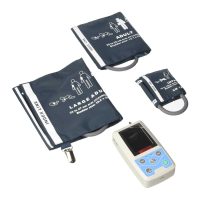
Do you have a question about the Gima ABPM50 and is the answer not in the manual?
| Model | ABPM50 |
|---|---|
| Measurement Method | Oscillometric |
| Blood Pressure Range | 0 - 280 mmHg |
| Accuracy Blood Pressure | ±3 mmHg |
| Display | LCD |
| Power Supply | 4 x AA batteries |
| Cuff Size | 22-32 cm |
| Pulse Rate Range | 40 to 199 beats/min |
Introductory remarks about the user manual and product usage.
Critical warnings and safety considerations before using the device.
Duties and responsibilities of the user operating the monitor.
Responsibilities of the company regarding product quality and support.
Essential safety guidelines and warnings for proper and safe operation.
Overview of the blood pressure monitor's features, capabilities, and general usage.
Detailed explanation of each button's function and operation on the device.
Description of the device's various connection ports and interface types.
List and description of the device's included and optional accessories.
Procedure for unpacking the device and checking for completeness and damage.
Step-by-step guide for inserting the device's batteries correctly.
Instructions on how to turn on the blood pressure monitor and start its operation.
Guidance on properly connecting the NIBP cuff and sensor to the device.
Description of the device's primary screen layout and key elements.
Details of the interface displayed during blood pressure measurement.
Explanation of how measurement results are presented on the screen.
Overview of accessing and navigating the device's system settings menu.
How to access and review stored measurement data for standard users.
Basic principles and modes of non-invasive blood pressure measurement.
Guidelines and best practices for obtaining accurate blood pressure readings.
Correct procedure for applying the NIBP cuff and performing measurements.
Useful tips and advice for efficient and effective device operation.
Common error codes displayed by the device and their corresponding troubleshooting steps.
Procedures for routine maintenance and cleaning of the device and accessories.
Guidelines for safe transportation and proper storage conditions for the device.
Explanation of device buttons, indicators, and symbols used in the manual.
Process for creating and registering a new user profile within the software.
Overview of the primary graphical user interface of the PC software.
Instructions on how to correctly wear the monitor for effective data collection.
Configuring measurement schedules, time periods, and intervals.
Steps for transferring measurement data from the device to a computer.
Procedure for selecting and opening saved patient data files.
Instructions on how to remove specific patient data files from the system.
Process for creating backup copies of patient data for safety and recovery.
Functionality to modify or correct recorded blood pressure measurement data.
Visual representation of blood pressure trends over time for analysis.
Viewing and interpreting statistical summaries of collected blood pressure data.
Entering and managing patient demographic, medical, and physician information.
Setting specific time periods for awake and asleep states for analysis.
Configuring custom thresholds for blood pressure alerts and data analysis.
Displaying the distribution of measurement data using histogram charts.
Visualizing data analysis and distribution through pie charts.
Analyzing the relationship and correlation between systolic and diastolic pressures.
Generating and configuring reports for printing from the collected data.
Accessing built-in help resources for software functions and operations.
Manufacturer's declaration regarding electromagnetic emissions and compliance.
Manufacturer's declaration concerning the device's immunity to electromagnetic fields.
Immunity guidelines for non-life-supporting equipment as per standards.
Instructions for the environmentally responsible disposal of the device.
Details regarding the manufacturer's standard warranty period and conditions.
